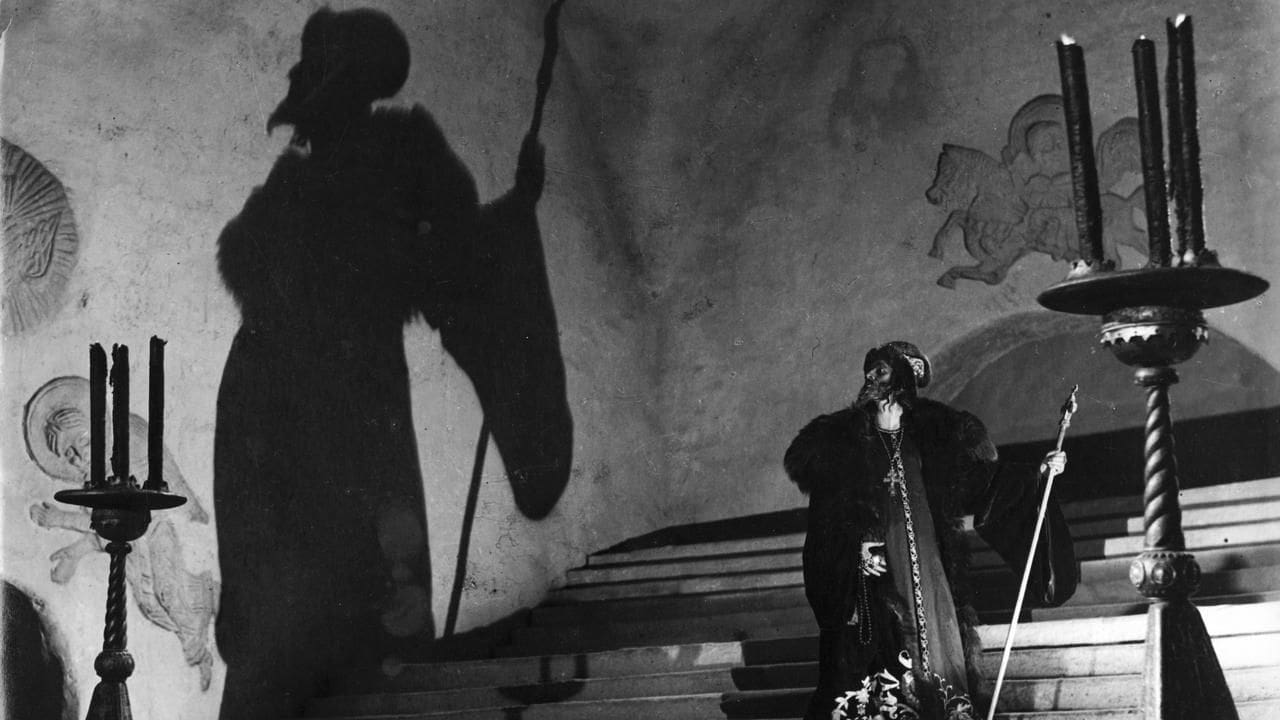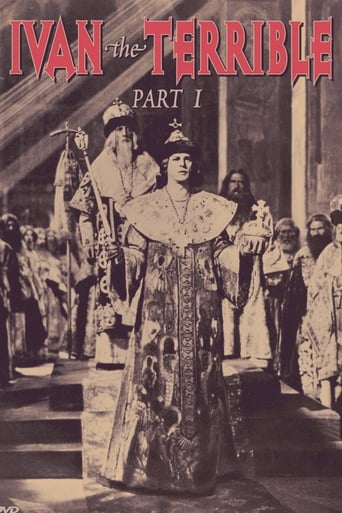

One of the worst movies I've ever seen
... View MoreBetter Late Then Never
... View MoreThe movie really just wants to entertain people.
... View MoreAmazing worth wacthing. So good. Biased but well made with many good points.
... View More(Movie Quote) - "You will answer for this before God!" And, was "Ivan The Terrible" terrible movie-making? No. As a matter of fact, it wasn't.Starting off with an incredibly freakish and super-surreal opening sequence, "Ivan The Terrible" (filmed in the mid-1940s, in 2 parts, totalling 187 minutes) is particularly notable for its position in foreign-movie history.Directed by Sergei Eisenstein, this lavish and equally bizarre film was actually commissioned by Soviet Premier, Joseph Stalin (who admired and identified himself with the title character). (It was later, though, that Stalin condemned said-film once Eisenstein had completed Part 2)I mean, you really have to see this wacky production for yourself to believe it. It certainly is loaded to the rafters with all sorts of hammy performances and unintentionally laughable scenes that are sure to provide some worthy moments of entertainment.Heavy-as-lead with religious and political ideology, this film's most outstanding asset was, of course, its striking cinematography that, at times, was like witnessing a historical nightmare as seen through the collective eyes of the highly subjective Russian citizens.
... View MoreWhile still a remarkable production, ITT-1 doesn't nearly reach the peaks of excellence of its namesake and sequel ITT-2. Technically is still great, a visual masterpiece, but there are several factors—natural or logical, fruit of the circumstances, etc—preventing it from becoming the classic the later is. For one thing, its episodic nature, which robs the film of an adequate building up of tensions, an emotional crescendo, culminating in a spectacular denouement as we see in the sequel, in those unforgettable dance & Church scenes. That's the problem with episodic plots, that much of the tension generated and accumulated in each episode, or that lingering from previous ones, dissolves during it, even more when closure comes with that ending, which leaves for the next episode the task of starting building tensions and focusing once again. We may compare both ITT-1 and 2, with two race cars starting both from the same point and then car 2 accelerating until reaching its maximum speed while car 1 goes stopping every hundred feet. That's what happens here with ITT-1 and its sequel. That's why the sequel is more exciting to watch, at it's far more focused, more tightly weaved as a story.The best ex. of what I'm saying about ITT-1 is the war on Kazan. It happens, then we never hear of it again, not even as a memory, its only contribution to the main plot line having been that establishes Ivan as a smart, strong and powerful conqueror, and that also informs us on the origins on the great trust he'll put later on the three men on which he would base his Oprishkina, the Basmanovs and Malyuta. That's very informative, of course, something we had to know, but it shows also the price ITT-1 pays for having come out first; for making possible for the sequel to be such an epic, as it's the one in charge of preparing the terrain for it, developing those themes and elements that will come to heed in the second part, the conflicts that will come clashing to the open. Different, unrelated, elements have to be gradually brought together to complete the required palette of characters and events. That's the task of ITT-1 and that's what makes its writing so dispersed and its action so unfocused.But apart from that there are also some flaws in the editing, the directing, that at times practically take us out of what should be the mood of the moment. For ex., the brush of Ivan with death comes immediately after his victory in Kazan; there's absolutely no transition there, no triumphal return to his people, like we see in Alexander Nevsky. Ivan wins the battle and next he's dying in bed (BTW, it's just me or that was just a trick to weasel out those he shouldn't trust? Come on, one moment he's dying and the next he's running around making speeches). Also the whole sequence is way too long, with and excruciatingly slow pace at times, which works against the pacing of the whole movie, as it totally clashes with that of the previous, the assault of Kazan. So, transitions are not always smooth here, many are even bumpy, abrupt, as if entire scenes had been edited out. That happens for ex. with Anastasia's death: she drinks the poisoned liquid and next we are already in her funeral.Despite all its faults, ITT-1 still makes for one movie worth watching, especially if you have already seen the sequel. Technically is still impeccable, the same attention to detail by the director; the same allegoric surroundings we see in ITT-2—after all both unfold in the same environment, the Czar's palace, the church, etc. Also present here are the trademark close ups on the purposely lighted faces of the actors, the focus on their expressionist eye movements and the middle shots exposing them against a background of deliberately chosen imagery—-as the fresco of a cadaverous face, a human skull, on a wall during funeral; the ever present combinations of light and shadows to create the expected mood. Also, contrary to other reviewers, I love these pompous, grandiloquent characters, so self-conscious all, who when talking seem to be pronouncing every one of their words for the Ages; each one seeming to believe they have some transcendental truth to communicate, some divine mission to accomplish, as they keep mentioning God as if certain that God was on their side. For someone more or less familiar with the works of Dostoevsky, Tolstoy, nothing less than what we see here is what we expect from a Russian epic, in the acting department. The only one I didn't quite like it is Nazvanov. He overacts most of his scenes, so much so at time he gave me the impression of watching a mime, a ballet dancer, rather than an actor.In all, technically as great as the sequel, and so the acting, but the pacing, the editing, the score, suffer somewhat, not the least because of official State meddling--Eisenstein wanted to begin the movie with the scenes of the young Ivan, but Stalin considered too depressing. 7.5/10.
... View MoreAnother one of these "must see" films that art houses used to play to a packed audience of students striving to see and ponder what has become known throughout the film world as a "masterpiece of its kind". And afterwards, overcome by the techniques mastered in filming this historical opus, they all declare that it is indeed the world's greatest film.Not so. Sure, the visuals are as stunning as any you will see in a current epic, but the script is a ponderous one that will try the patience of anyone waiting for something to happen. It's full of operatic excesses in the way all the close-ups of wide-eyed hysteria are filmed in a Gothic blend of shadow and light, with the principal actors overplaying their bigger than life emotions as though they were on a stage in a theater of at least 6,000 seats.Nothing subtle about these portrayals and yet they remain fixed in the mind afterwards, endlessly fascinating in the way these characters are presented on screen. Ivan the Terrible looks more like one's conception of Rasputin with his stringy beard and look of menace that would put Bela Lugosi to shame. He resembles John Barrymore in full make-up.The settings and costumes are all in keeping with the brooding 16th Century Russian atmosphere and the soundtrack is full of Russian chants to further the mood.Lacking subtlety due to their silent screen poses and operatic expressions are Nikolai Cherkasov as Czar Ivan IV and Lyudmila Tselikovskaya as Czarina Anastasia Staritskaya. She strongly resembles a cross between Katina Paxinou and Martita Hunt, as the woman who unwittingly sacrifices her son for the throne.The final scenes leading up to the tragic death of the Czarina's son are beautifully composed and visually compelling to watch, especially those scenes photographed in vivid color (with an accent on blood red), still making use of stark, shadowy images.But a masterpiece? Not by today's standards. Worth watching? Indeed.
... View MoreWell I will come clean and admit that I was forced as part of my history degree to watch this film, and then write a short film review as part of my grade.Yet even if I had watched the film alone, at my own discretion I found it extremely boring and absurd. The style is dated beyond its years, and the acting is farcical. Rather than use dialogue they instead exchange eye popping glances at each other, or sometimes into thin air. For me, such over the top acting does not convey any greater emotion, and after seeing an extreme close up Ivan's face for the hundredth time I was praying for the film to end.The most disappointing though is how wrong Ivan's character is. This man was nasty, his bodyguard's murderous thugs and his character cowardly. For me the film was nothing but a piece of Stalin propaganda, inaccurate and dull.
... View More